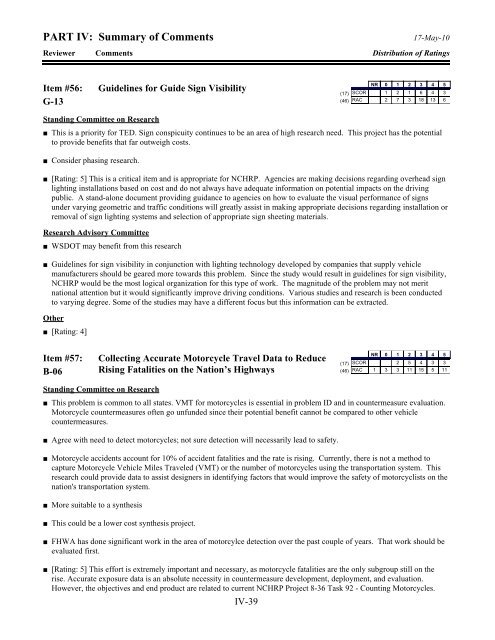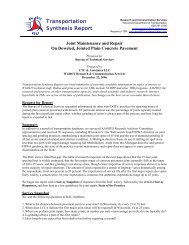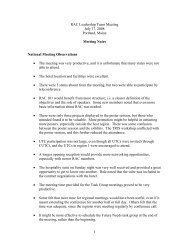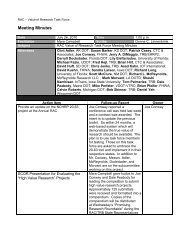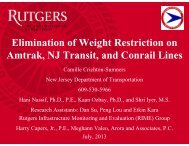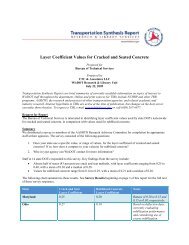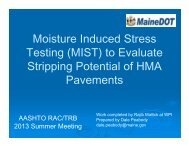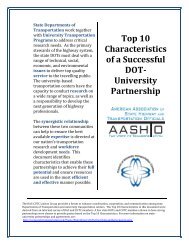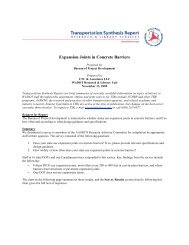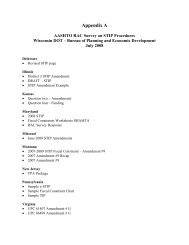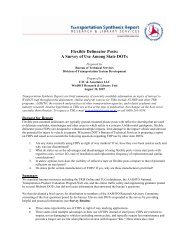PART IV: Summary of Comments - SCOR/RAC
PART IV: Summary of Comments - SCOR/RAC
PART IV: Summary of Comments - SCOR/RAC
Create successful ePaper yourself
Turn your PDF publications into a flip-book with our unique Google optimized e-Paper software.
<strong>PART</strong> <strong>IV</strong>: <strong>Summary</strong> <strong>of</strong> <strong>Comments</strong>17-May-10Reviewer <strong>Comments</strong> Distribution <strong>of</strong> RatingsItem #56:G-13Guidelines for Guide Sign Visibility(17)(46)NR 0 1 2 3 4 5<strong>SCOR</strong> 1 2 1 6 4 3<strong>RAC</strong> 2 7 3 18 13 6Standing Committee on Research■ This is a priority for TED. Sign conspicuity continues to be an area <strong>of</strong> high research need. This project has the potentialto provide benefits that far outweigh costs.■ Consider phasing research.■ [Rating: 5] This is a critical item and is appropriate for NCHRP. Agencies are making decisions regarding overhead signlighting installations based on cost and do not always have adequate information on potential impacts on the drivingpublic. A stand-alone document providing guidance to agencies on how to evaluate the visual performance <strong>of</strong> signsunder varying geometric and traffic conditions will greatly assist in making appropriate decisions regarding installation orremoval <strong>of</strong> sign lighting systems and selection <strong>of</strong> appropriate sign sheeting materials.Research Advisory Committee■ WSDOT may benefit from this research■ Guidelines for sign visibility in conjunction with lighting technology developed by companies that supply vehiclemanufacturers should be geared more towards this problem. Since the study would result in guidelines for sign visibility,NCHRP would be the most logical organization for this type <strong>of</strong> work. The magnitude <strong>of</strong> the problem may not meritnational attention but it would significantly improve driving conditions. Various studies and research is been conductedto varying degree. Some <strong>of</strong> the studies may have a different focus but this information can be extracted.Other■ [Rating: 4]Item #57:B-06Collecting Accurate Motorcycle Travel Data to ReduceRising Fatalities on the Nation’s Highways(17)(46)NR 0 1 2 3 4 5<strong>SCOR</strong> 2 5 4 3 3<strong>RAC</strong> 1 3 3 11 15 5 11Standing Committee on Research■ This problem is common to all states. VMT for motorcycles is essential in problem ID and in countermeasure evaluation.Motorcycle countermeasures <strong>of</strong>ten go unfunded since their potential benefit cannot be compared to other vehiclecountermeasures.■ Agree with need to detect motorcycles; not sure detection will necessarily lead to safety.■ Motorcycle accidents account for 10% <strong>of</strong> accident fatalities and the rate is rising. Currently, there is not a method tocapture Motorcycle Vehicle Miles Traveled (VMT) or the number <strong>of</strong> motorcycles using the transportation system. Thisresearch could provide data to assist designers in identifying factors that would improve the safety <strong>of</strong> motorcyclists on thenation's transportation system.■ More suitable to a synthesis■ This could be a lower cost synthesis project.■ FHWA has done significant work in the area <strong>of</strong> motorcylce detection over the past couple <strong>of</strong> years. That work should beevaluated first.■ [Rating: 5] This effort is extremely important and necessary, as motorcycle fatalities are the only subgroup still on therise. Accurate exposure data is an absolute necessity in countermeasure development, deployment, and evaluation.However, the objectives and end product are related to current NCHRP Project 8-36 Task 92 - Counting Motorcycles.<strong>IV</strong>-39


